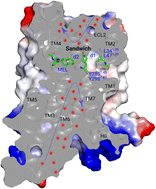Molecular basis of ligand selectivity for melatonin receptors†
Abstract
Sleep disorders in adults are related to adverse health effects such as reduced quality of life and increased mortality. About 30–40% of adults are suffering from different sleep disorders. The human melatonin receptors (MT1 and MT2) are family A G protein-coupled receptors that respond to the neurohormone melatonin MEL which regulates circadian rhythm and sleep. Many efforts have been made to develop drugs targeting melatonin receptors to treat insomnia, circadian rhythm disorders, and even cancer. However, designing subtype-selective melatonergic drugs remains challenging due to their high similarities in both sequences and structures. MEL (a function-selective compound with a bulky β-naphthyl group) behaves as an MT2-selective antagonist, whereas it is an agonist of MT1. Here, molecular dynamics simulations were used to investigate the ligand selectivity of MT receptors at the atomic level. We found that the binding conformation of MEL differs in different melatonin receptors. In MT1, the naphthalene ring of MEL forms a structure perpendicular to the membrane surface. In contrast, there is a 130° angle between the naphthalene ring of MEL and the membrane surface in MT2. Because of this conformational difference, the MEL leads to a constant water channel in MT1 which activates the receptor. However, MEL hinders the formation of continuous water channels, resulting in an inactive state of MT2. Furthermore, we found that A1173.29 in MT2 is a crucial amino acid capable of hindering the conformational flip of the MEL molecule. These results, coupled with previous functional data, reveal that although MT1 and MT2 share highly similar orthosteric ligand-binding pockets, they also display distinctive features that could be used to design selective compounds. Our findings provide new insights into functionally selective melatonergic drug development for sleep disorders.



 Please wait while we load your content...
Please wait while we load your content...